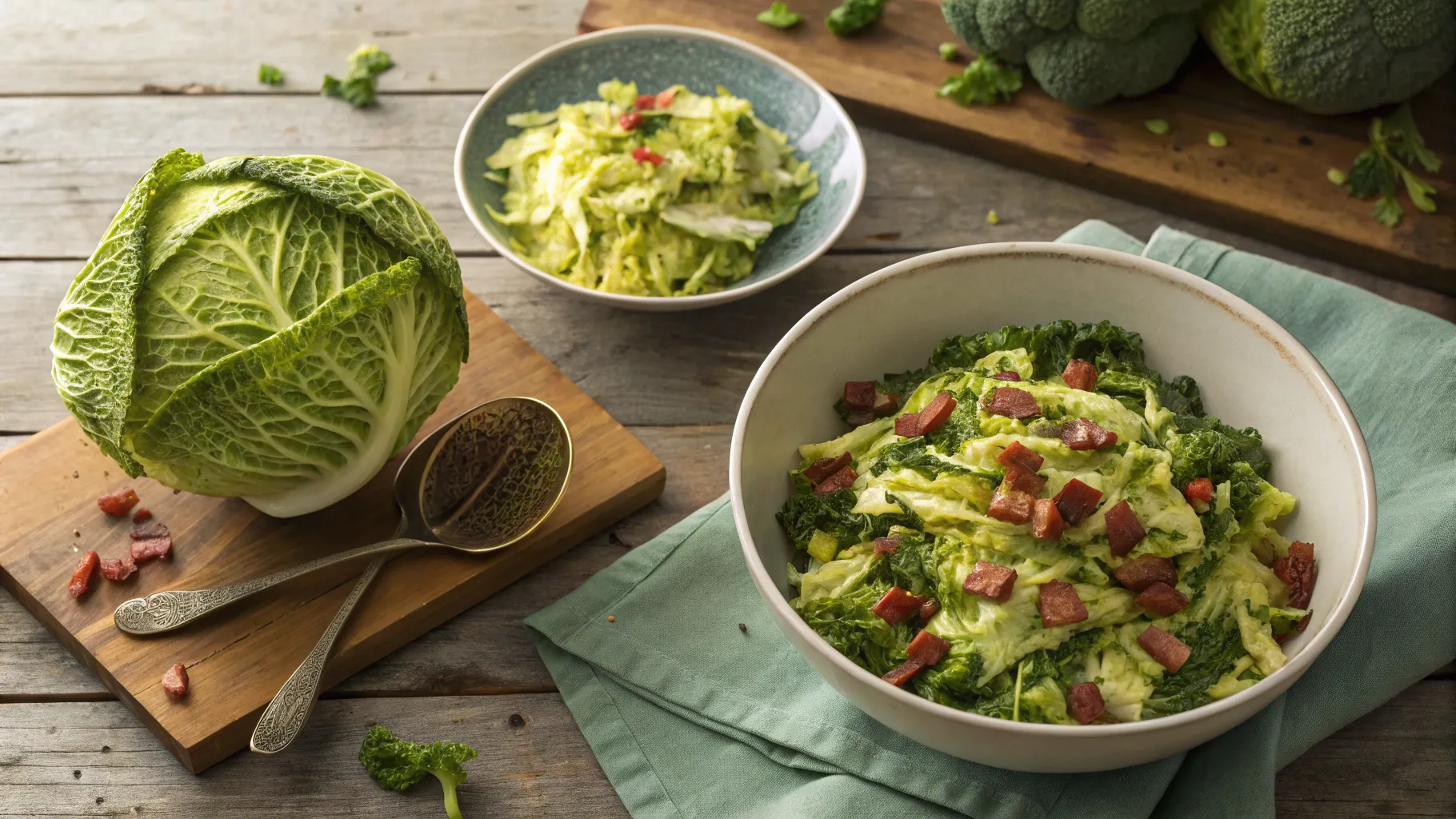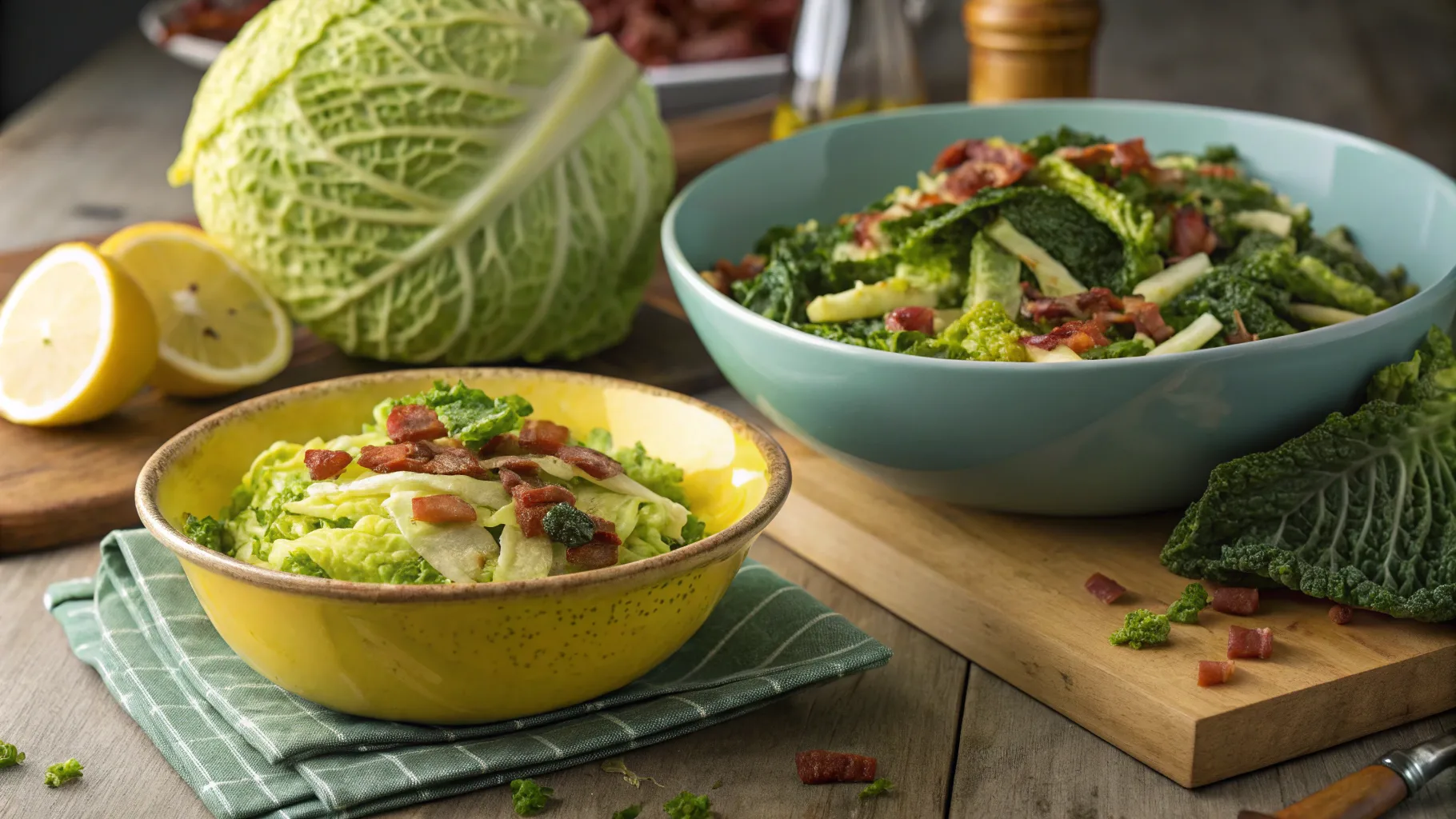Picture yourself standing in the grocery store, examining that gorgeous head of savoy cabbage with its beautifully crinkled leaves. You reach for it, then hesitate. Unlike regular cabbage, this variety seems more sophisticated, almost mysterious. Perhaps you’ve experienced this exact moment – drawn to its vibrant appearance yet uncertain about transforming it into something delicious.
Your hesitation makes perfect sense. Many home cooks bypass savoy cabbage simply because they lack confidence in preparing it. However, this remarkable vegetable deserves a place in your regular cooking rotation. Once you discover how forgiving and versatile it becomes in the kitchen, you’ll wonder why you waited so long to embrace it.
These five carefully selected recipes will guide you through your savoy cabbage journey, building your culinary confidence with each dish. Every recipe focuses on simplicity without sacrificing flavor, ensuring your success from the very first attempt.
What Makes Savoy Cabbage Perfect for Beginner Cooks
Understanding Savoy Cabbage vs. Regular Cabbage
Savoy cabbage distinguishes itself through its distinctive crinkled, ruffled leaves that feel softer and more pliable than traditional smooth cabbage varieties. This textural difference translates directly into cooking advantages for beginners.
https://www.allrecipes.com/recipe/263047/easy-savoy-cabbage/While regular cabbage can become tough and bitter when overcooked, savoy cabbage maintains its tender texture even with extended cooking times. Its naturally sweeter flavor profile means you’ll encounter fewer bitter notes that sometimes discourage novice cooks from experimenting with cruciferous vegetables.
The leaves separate more easily during preparation, making cutting and handling significantly simpler. You’ll spend less time wrestling with tough cores and stubborn leaves, allowing you to focus on developing your cooking techniques instead.
Nutritional Benefits That Make It Worth Learning
Your investment in learning savoy cabbage preparation pays dividends in nutritional value. This powerhouse vegetable delivers more vitamin C per serving than most citrus fruits, supporting your immune system while adding minimal calories to your meals.
Each cup provides substantial fiber content, promoting digestive health and helping you feel satisfied longer. The antioxidants present in those dark green leaves combat inflammation and support overall wellness.
For budget-conscious cooks, savoy cabbage offers exceptional nutritional bang for your buck. One head typically costs less than premium salad greens while providing multiple servings of nutrient-dense food.
Why Beginners Love Working with Savoy Cabbage
Several characteristics make savoy cabbage particularly beginner-friendly:
- Forgiving cooking times prevent overcooking disasters
- Mild flavor pairs well with various seasonings and proteins
- Available year-round in most grocery stores
- Stores well in your refrigerator for extended periods
- Requires minimal specialized equipment or techniques
Essential Tips for Preparing Savoy Cabbage
How to Select the Perfect Head

Your recipe success begins with proper selection. Look for heads that feel heavy for their size, indicating good moisture content and freshness. The outer leaves should display vibrant green coloring without yellow spots or wilted edges.
Gently squeeze the head – it should feel firm and compact rather than loose or spongy. Medium-sized heads typically offer the best balance of tenderness and value, while extremely large heads sometimes develop tougher textures.
Proper Storage and Preparation Techniques
Store your savoy cabbage in the refrigerator’s crisper drawer, where it maintains quality for up to one week. Avoid washing until you’re ready to use it, as excess moisture accelerates spoilage.
When preparing, remove any damaged outer leaves before cutting. The core removal process involves cutting the cabbage in half, then making a diagonal cut to remove the triangular core section. This technique ensures even cooking throughout your dish.
Recipe #1: Simple Sautéed Savoy Cabbage with Garlic
Ingredients
| Ingredient | Amount | Notes |
|---|---|---|
| Savoy cabbage | 1 medium head (2 lbs) | Core removed, roughly chopped |
| Olive oil | 3 tablespoons | Extra virgin preferred |
| Garlic | 4 cloves | Minced |
| Salt | 1 teaspoon | To taste |
| Black pepper | 1/2 teaspoon | Freshly ground |
| Red pepper flakes | 1/4 teaspoon | Optional |
Cooking Method
Heat your olive oil in a large skillet over medium-high heat. Add minced garlic and cook for 30 seconds until fragrant, being careful not to burn it.
Add your chopped savoy cabbage to the skillet – it will seem like a lot initially, but it reduces significantly as it cooks. Season with salt and pepper, then stir frequently for 6-8 minutes until the cabbage wilts and becomes tender.
The finished dish should retain slight texture while being completely tender. Sprinkle with red pepper flakes if desired, and serve immediately as a side dish or over rice as a light main course.
Recipe #2: Hearty Savoy Cabbage and Sausage Skillet
Ingredients
| Ingredient | Amount | Notes |
|---|---|---|
| Savoy cabbage | 1 small head (1.5 lbs) | Sliced thin |
| Italian sausage | 1 lb | Casings removed |
| Yellow onion | 1 medium | Sliced |
| Bell pepper | 1 large | Any color, sliced |
| Chicken broth | 1/2 cup | Low sodium |
| Olive oil | 2 tablespoons | |
| Italian seasoning | 1 teaspoon |
Preparation Steps
Brown the sausage in a large skillet over medium heat, breaking it into bite-sized pieces as it cooks. Remove the cooked sausage and set aside, leaving the rendered fat in the pan.
Add sliced onions and bell peppers to the same skillet, cooking until softened, approximately 5 minutes. Add the sliced savoy cabbage and Italian seasoning, stirring to combine.
Pour in the chicken broth and return the sausage to the skillet. Cover and simmer for 10-12 minutes until the cabbage reaches your desired tenderness. This one-pan meal provides complete nutrition and satisfying flavors.
Recipe #3: Asian-Inspired Savoy Cabbage Stir-Fry
Ingredients
| Ingredient | Amount | Notes |
|---|---|---|
| Savoy cabbage | 1 small head | Cut into strips |
| Soy sauce | 3 tablespoons | Low sodium |
| Sesame oil | 1 tablespoon | |
| Vegetable oil | 2 tablespoons | For cooking |
| Fresh ginger | 1 tablespoon | Minced |
| Garlic | 3 cloves | Minced |
| Green onions | 3 stalks | Sliced |
| Sesame seeds | 1 tablespoon | For garnish |
Stir-Fry Technique
Combine soy sauce and sesame oil in a small bowl to create your sauce. Heat vegetable oil in a wok or large skillet over high heat until it shimmers.
Add ginger and garlic, stir-frying for 30 seconds until aromatic. Add the cabbage strips and stir-fry for 3-4 minutes until they begin to wilt but retain some crunch.
Pour the sauce mixture over the cabbage and toss to coat evenly. Remove from heat and garnish with sliced green onions and sesame seeds. Serve over steamed rice or enjoy as a light standalone dish.
Recipe #4: Creamy Savoy Cabbage Soup
Ingredients
| Ingredient | Amount | Notes |
|---|---|---|
| Savoy cabbage | 1 medium head | Chopped |
| Potatoes | 2 medium | Yukon Gold, diced |
| Vegetable broth | 4 cups | Or chicken broth |
| Heavy cream | 1/2 cup | Can substitute milk |
| Butter | 2 tablespoons | |
| Onion | 1 medium | Diced |
| Fresh thyme | 1 teaspoon | Or 1/2 teaspoon dried |
Soup Preparation
Melt butter in a large pot over medium heat. Add diced onion and cook until translucent, about 5 minutes. Add chopped cabbage and diced potatoes, stirring to coat with butter.
Pour in the broth and add thyme. Bring to a boil, then reduce heat and simmer for 20-25 minutes until potatoes are tender and cabbage is completely softened.
Stir in heavy cream and season with salt and pepper to taste. For a smoother texture, use an immersion blender to partially puree the soup, leaving some chunks for texture.
Recipe #5: Simplified Stuffed Cabbage Rolls
Ingredients
| Ingredient | Amount | Notes |
|---|---|---|
| Large savoy cabbage leaves | 8 leaves | Blanched |
| Ground turkey | 1 lb | Or ground beef |
| Cooked rice | 1 cup | White or brown |
| Onion | 1 small | Minced |
| Egg | 1 large | Beaten |
| Tomato sauce | 2 cups | Divided |
| Garlic powder | 1 teaspoon | |
| Paprika | 1 teaspoon |
Assembly Process
Blanch cabbage leaves in boiling water for 3-4 minutes until pliable. Remove and cool under cold water.
Mix ground turkey, cooked rice, minced onion, beaten egg, 1/2 cup tomato sauce, garlic powder, and paprika in a large bowl. Place 1/4 cup of filling on each cabbage leaf, roll tightly, and secure with toothpicks if needed.
Place rolls seam-side down in a baking dish. Pour remaining tomato sauce over the rolls and cover with foil. Bake at 350°F for 45 minutes until heated through and tender.
Troubleshooting Common Beginner Mistakes
Avoiding Overcooking Issues
Watch for visual cues rather than relying solely on timing. Properly cooked savoy cabbage maintains bright color and slight firmness. If it turns gray or becomes mushy, you’ve cooked it too long.
Balancing Flavors
Savoy cabbage’s natural sweetness pairs beautifully with acidic ingredients like lemon juice or vinegar. If your dish tastes flat, add a splash of acid to brighten the flavors.
Achieving Perfect Texture
Cut your cabbage into uniform pieces to ensure even cooking. Thicker pieces require longer cooking times, while thin strips cook quickly and can become overdone if you’re not careful.
Your Culinary Adventure Begins Now
These five easy savoy cabbage recipes for beginners provide the foundation for expanding your vegetable cooking repertoire. Each recipe builds upon basic techniques while introducing new flavors and cooking methods.
Start with the simple sautéed version to familiarize yourself with how savoy cabbage behaves during cooking. Once you’ve mastered that technique, challenge yourself with the stir-fry or soup recipes.
Remember that cooking confidence develops through practice and experimentation. Don’t worry about achieving perfection on your first attempt – focus on learning and enjoying the process.
Your next grocery trip should definitely include a beautiful head of savoy cabbage. Choose your favorite recipe from this collection, gather your ingredients, and transform that gorgeous vegetable into a delicious meal that will surprise and delight everyone at your table.

